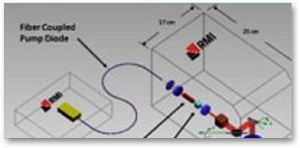Brief Overview of Laser Marking Machines
A laser diode (1) generates laser light that travels down a fiber optic cable (2) and enters the laser head. The laser head (5) which contains an Nd:YVO4 (Vanadate) laser crystal (3), produces intense, short pulses of laser light. These pulses are directed onto the work piece (8) by a pair of computer controlled scanning mirrors (6). A portion of each laser pulse is absorbed by the work piece depending on the properties of the material. When marking, each pulse creates a chemical change in the work piece’s surface, producing a smooth visible mark. When engraving, each pulse physically removes material from the work piece (a process known as laser ablation), producing a tiny hole with each pulse.
Full Description of Laser Marking Machines
The semiconductor laser diode (1) takes electricity as input and produces laser light as output. The laser diode emits continuous wave (CW) laser light at a wavelength of 808 nm. Since the output wavelength depends strongly on the diode temperature, the markers utilize a thermo- electric cooling system which guarantees that the laser head (5) receives stable input. The laser light from the diode travels from the controller through a fiber optic cable (2) to the laser head (5), which is situated inside the marker.
The laser head (5) contains a number of optical elements, most importantly an Nd:YVO4 (Vanadate) laser crystal (3) and a Q-switch (4). The Vanadate crystal absorbs the 808 nm laser light from the diode (1) as input and produces continuous wave (CW) laser light at a wavelength of 1064 nm. The Q-switch (4) converts the CW light from the Vanadate crystal to a stream of light pulses. As a simple analogy, imagine kinking a garden hose for a second and then releasing it. The kink-and-release process is repeated very rapidly. In this manner, a big pulse of water is produced at regular intervals from a steady input stream. A Q-switched, Vanadate laser follows a similar pattern. While the Q-switch (4) is closed, the laser diode (1) fills the Vanadate crystal (3) with energy. When the Q-switch is opened, the stored energy comes out of the crystal as very short, intense pulses of laser light. The Q-switch is capable of opening and closing 1,000 to 70,000 times per second.
The pulses of laser light that emerge from the laser head (5) are directed to a pair of scanning mirrors (6). The mirrors are rapidly tilted using galvo-scanners. Software running on a desktop or a laptop computer controls the motion of the mirrors, directing each pulse to the proper location on the work piece (8).
The laser pulses that leave the scanning mirrors (6) pass through a specially designed lens (7), known as an F-Theta lens, which focuses them onto the work piece (8). The F-Theta lens is the final component of the marking system; it is specially designed to produce a flat, tightly focused image on the work piece, typically less than 40 microns (less than 2/1000ths of an inch) across. In this manner, a high resolution mark is obtained. Additionally, by squeezing the energy contained in each pulse into the smallest possible spot, the marking/engraving capability of each pulse is amplified, increasing both the quality and speed of the marking process.


